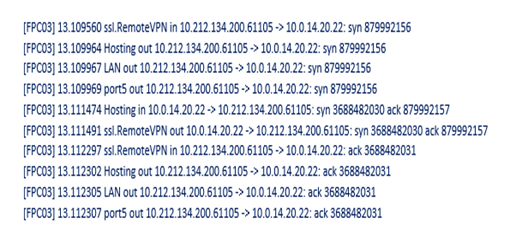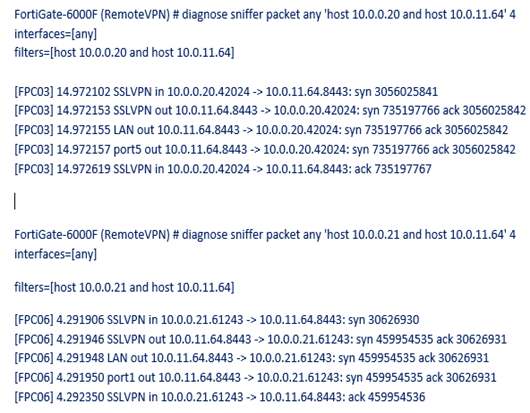- Support Forum
- Knowledge Base
- Customer Service
- Internal Article Nominations
- FortiGate
- FortiClient
- FortiADC
- FortiAIOps
- FortiAnalyzer
- FortiAP
- FortiAuthenticator
- FortiBridge
- FortiCache
- FortiCare Services
- FortiCarrier
- FortiCASB
- FortiConverter
- FortiCNP
- FortiDAST
- FortiData
- FortiDDoS
- FortiDB
- FortiDNS
- FortiDLP
- FortiDeceptor
- FortiDevice
- FortiDevSec
- FortiDirector
- FortiEdgeCloud
- FortiEDR
- FortiEndpoint
- FortiExtender
- FortiGate Cloud
- FortiGuard
- FortiGuest
- FortiHypervisor
- FortiInsight
- FortiIsolator
- FortiMail
- FortiManager
- FortiMonitor
- FortiNAC
- FortiNAC-F
- FortiNDR (on-premise)
- FortiNDRCloud
- FortiPAM
- FortiPhish
- FortiPortal
- FortiPresence
- FortiProxy
- FortiRecon
- FortiRecorder
- FortiSRA
- FortiSandbox
- FortiSASE
- FortiSASE Sovereign
- FortiScan
- FortiSIEM
- FortiSOAR
- FortiSwitch
- FortiTester
- FortiToken
- FortiVoice
- FortiWAN
- FortiWeb
- FortiAppSec Cloud
- Lacework
- Wireless Controller
- RMA Information and Announcements
- FortiCloud Products
- ZTNA
- 4D Documents
- Customer Service
- Community Groups
- Blogs
- Fortinet Community
- Knowledge Base
- FortiGate
- Technical Tip : How to load balance SSL VPN web-mo...
- Subscribe to RSS Feed
- Mark as New
- Mark as Read
- Bookmark
- Subscribe
- Printer Friendly Page
- Report Inappropriate Content
Created on
04-30-2020
10:31 PM
Edited on
11-23-2021
01:26 AM
By
Anthony_E
Description
This article describes the work around for SSLVPN load balancing limitation.
Scope
FortiGate-6000 series.
Solution
The FortiGate-6000 does not support load balancing SSL VPN sessions.
The recommended configuration is to direct SSL VPN sessions terminated by the FortiGate-6000 to the primary FPC.
This requires a flow rule to be manually added on Fortigate-6000.
See below for example, it matches all sessions sent to port 8443 (SSLVPN listening port) and forward to Master FPC.
It applies to both web mode traffic and tunnel mode traffic. In the example, web mode SSL VPN traffic is sent to IP address 10.0.11.64 port 8443 and tunnel mode SSL VPN is sent to IP address 10.0.11.65 port 8443.
It degrades the performance of Mater FPC when RDP over SSLVPN web mode traffic increases.
# config load-balance flow-rule
edit 0
set status enable
set ether-type ipv4
set protocol tcp
set dst-l4port 8443-8443
set forward-slot master
set comment "ssl vpn server to primary FPC"
next
end
To work around this limitation:
- Web mode traffic can be load balanced to all FPCs.
- Tunnel mode traffic can be offloaded to Master or any single FPC since it cannot be offloaded/load-balanced to multiple slots at a time due to VPN IP pool conflict
It can be achieved by configuring the secondary IP address for the existing interface that receives the SSLVPN traffic and a flow rule to forward all the tunnel traffic to it as a destination address with destination port.
Change the 'dp-load-distribution 'method' is set to 'src-dst-ip method.
Note:
By default, load balancing method is set to src-dst-ip-sport-dport (L4). If dp-load-distribution-method is set to src-dst-ip method, there is a 10GB bandwidth limitation on DP for connections started from same client go to same destination. For example, huge backups from same source and destination may experience slowness due to DP 10G bandwidth limitation.
Configuration steps to implement this workaround.
It is recommended to perform the following procedure during a scheduled maintenance window.
- Use secondary IP on interface to listen SSLVPN sessions
- Changing load balancing method to src-dst-ip (L3) from src-dst-ip-sport-dport (L4)
- Forward all tunnel mode traffic to Master or any FPC on secondary IP.
Network Topology.
This configuration accepts SSL VPN web mode connections at IP address 10.0.11.64, port 8443 and load balances them to all FPCs.
This configuration also accepts SSL VPN tunnel mode connections at IP address 10.0.11.65, port 8443 and sends them to FPC3.
Tunnel-mode.
Remote user-----wan----6k(all FPCs)---------LAN
Primary IP
10.0.11.64
port 8443
Tunnel-mode
Remote user ----wan----6K(FPC3)-------------LAN
Secondary IP
10.0.11.65
port 8443
1) To configure a secondary IP address.
From GUI.
Go to Network -> Interfaces, select 'Edit' or 'Create New' and enable the secondary IP address option and create the secondary IP address 10.0.11.65. Select 'OK'.
edit "SSLVPN"
set vdom "RemoteVPN"
set ip 10.0.11.64 255.255.255.0
set secondary-IP enable
set interface "LAN"
set vlanid 311
config secondaryip
edit 1
set ip 10.0.11.65 255.255.255.0
next
end
2) Change the load balancing method to 'src-dst-ip'.
SSL VPN web mode traffic to the primary IP is load balanced using 'src-dst-ip' load balancing.
# config global
# config load-balance setting
set dp-load-distribution-method src-dst-ip
end
3) Add a new load balancing flow rule to forward SSL VPN tunnel traffic to FPC3. The flow rule must have destination IP 10.0.11.65 255.255.255.255 and destination port 8443.
For example: Tunnel traffic forwarded to FPC 3.
# config load-balance flow-rule
edit 0
set status enable
set ether-type ipv4
set dst-addr-ipv4 10.0.11.65 255.255.255.255
set dst-l4port 8443-8443
set forward-slot FPC3
set comment "SSLVPN tunnel traffic to FPC 3"
end
4) Disable all other SSL VPN flow rules.
Once the above configuration is applied and users connect to SSL VPN using tunnel mode, the sessions created on FPC 3 are visible.


Sniffer output :


Related Articles
Technical Tip: SSL VPN in web mode use a lot of CPU and memory resources
The Fortinet Security Fabric brings together the concepts of convergence and consolidation to provide comprehensive cybersecurity protection for all users, devices, and applications and across all network edges.
Copyright 2025 Fortinet, Inc. All Rights Reserved.